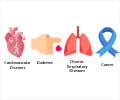India's survey has reported on the rising burden of non-communicable diseases (NCD) in the country, said sources.

‘An imbalanced diet includes a diet low in legumes, milk, omega-3 fatty acids, vegetables, fruits, calcium etc. High consumption of sugar and trans-fats due to growing urbanization often leads to sedentary and stressed lifestyle also contribute to factors that lead to an imbalanced diet.’





Calling diabetes an overpowering non-communicable disease, Dr. Ambrish Mittal, Chairman and Head, Endocrinology and Diabetes Department, Max Healthcare (Pan Max), said, "Diabetes has risen exponentially in India from 2 per cent in the 1970s in urban areas to between 10-20 per cent in 2020. The cases of diabetes are even higher in metros at 35-40 per cent. This spike is linked to urbanization led by economic development and has been more prevalent in urban areas as compared to rural areas." The Covid-19 pandemic has brought a sharper focus on health care. Patterns emerging from Covid management across the country indicate that people with co-morbidities of non-communicable diseases (NCDs) have a higher mortality rate than those who do not.
Report prepared by Thought Arbitrage Research Institute (TARI), the survey report observed that India's non-communicable disease burden is growing at an alarming rate with the average age for onset falling sharply.
It reported that NCDs increase after 18 years and show a quantum leap when an individual crosses the age of 35 years. It found that more than 2/3 of the individuals suffering from NCDs are in the most productive-life age groups i.e., between 26-59 years. This is an alarming trend and points to the grim reality that the burden of NCDs on India is long-lasting given that 65 per cent of the country's population is below 35 years of age.
The survey suggested that the prevalence of having any NCDs among the population is 116 per 1,000 population in India. It identified hypertension, digestive disease, and diabetes as the top three NCDs followed by respiratory diseases, brain/neurological disorders, heart diseases/CVD, kidney disorders, and cancer in the order of prevalence.
Advertisement
On a collective basis, the report identified air pollution as the most prevalent risk factor among the surveyed population. It was trailed by low physical activity -- a key metabolic and physical activity and an imbalanced diet, a behavioural risk factor that occupied 3rd spot.
Throwing light on the co-morbidity of NCDs with each other, the study underlined that hypertension has the highest comorbidity with almost all NCDs. This is followed by diabetes, kidney, and digestive disorders in their relative simultaneous occurrence in morbidity. This coexistence, according to the survey, is followed by diabetes and respiratory diseases. On the other hand, cancer and kidney disease were found to have lower comorbidity.
The state of Odisha was found to have the highest prevalence of NCDs (272 per 1,000 population) while Gujarat registered the lowest prevalence (60 per 1,000). Andhra Pradesh, Telangana, and West Bengal were other states where NCD prevalence was higher than the national average. This calls for state-specific strategies to tackle NCDs.
Source-IANS









